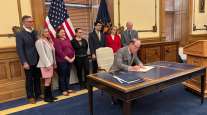Panel Endorses More P3 Infrastructure Investment
 Bartlett, Garvey, Cisneros, Story, Peterson by David Elfin/Transport Topics
Bartlett, Garvey, Cisneros, Story, Peterson by David Elfin/Transport TopicsWASHINGTON — An Infrastructure Week panel at the Bipartisan Policy Center on May 16 advocated for public-private partnerships to fill about half of the nation’s infrastructure funding gap that will top $1 trillion by 2025.
The panel, moderated by former Dallas Mayor Steve Bartlett, included: ex-Housing and Urban Development Secretary Henry Cisneros; Jane Garvey, former administrator of the Federal Highway Administration and the Federal Aviation Administration; S&P Global CEO Doug Peterson; and American Water CEO Susan Story.
INFRASTRUCTURE WEEK COVERAGE: Via TT's Capitol Agenda
“Our country faces an enormous challenge,” said Peterson, noting that much American infrastructure is nearing the end of its useful life while its maintenance has been deferred and the population continues to grow. “The numbers are daunting. The needs of the country don’t match what the opportunities are for the financing available.”
Both Peterson and closing speaker Eric Cantor, the former House Majority Leader who’s now vice chairman of Moelis, Inc., said the private sector is ready to invest in public infrastructure for the long-term.
Cisneros, who fears the U.S. is falling behind other nations in public-private partnerships, or P3s, cited a disconnect between Americans’ preference for the private sector and the tradition of public control of infrastructure.
“There simply isn’t the money in the public sector” to cover the needs, he said. Cisneros, previously the mayor of San Antonio, called infrastructure “the future of economic development.”
Peterson and Story are the co-chairpersons of the BPC’s just-issued report “Bridging The Gap: A New Model To Modernize American Infrastructure,” a product of a year of research that included visits to several major metropolitan areas to get a feel for the kind of infrastructure projects that work and how P3s can help.
The report stresses that P3s should clearly state the public value of a project, its full lifecycle costs, and the risks of building and not building it. It says P3s should fully share risks, costs and benefits between the public and private sectors.
Only 27 of the 50 states currently allow P3s for infrastructure projects and some of those don’t cover roads, water and transit. That irritates Story, who advocated for what she termed “full optionality” and local control of how to deliver P3s.
Garvey agreed that projects need “a local champion.”
Story said the nation has to stop “putting out fires” such as the lead in Flint, Michigan’s water pipes and the breakdowns in Washington’s Metro and think long-term when it comes to infrastructure. Asked what would happen in 20 years if the nation doesn’t turn to P3s, Peterson, a resident of New York City, said much of U.S. infrastructure would resemble that of his adopted hometown.




